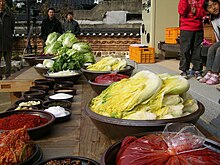利用者:Kizhiya/sandbox-a
| キムジャン | |
|---|---|
 キムジャンの準備:キムチを大量に作るための食材 | |
| 各種表記 | |
| ハングル: | 김장 |
| RR式: | gimjang |
| MR式: | kimjang |
キムジャン (ハングル: 김장), またはキムジャン[1] は、韓国朝鮮で冬期に食べられる発酵野菜料理キムチを、準備と保存を行うための伝統的な工程である。 is the traditional process of preparation and preservation of kimchi, the spicy Korean fermented vegetable dish, in the wintertime.[2] 夏の間、キムチは新鮮な、季節の野菜からつくられる[2]。
For one month, starting from the tenth month of the year, people prepare large quantities of kimchi that will last throughout the winter.
新年から10ヶ月目に、人々は冬の期間ずっと食べられる大量のキムチを準備する。[3][4]。
キムジャンは、2013年12月に、無形文化財に加わった。
Gimjang was listed as a UNESCO Intangible Cultural Heritage in December 2013[5] and the 133rd Korean Intangible Cultural Property.
Background
[編集]背景
[編集]キムチはほとんどあらゆる食事と一緒に食べることができ、朝鮮文化の重要な一部である[2]。
Kimchi can be eaten as an accompaniment to almost any meal and is an important part of Korean culture.[2]
野菜や漬物、そして塩、あるいはアルコールと塩の混ぜたもののどちらかも含めると、
Recipes date back to at least the 13th century,
作り方は少なくとも13世紀にまで遡る。
[3] when it was made from vegetables, pickles, and either salt or a mixture of alcohol and salt.[6]
17世紀に、唐辛子が食材に加わった。
Red pepper was added to the ingredients in the 17th century.[3]
Modern-day kimchi is typically made from napa cabbage and white radish, although there are hundreds of variations;
【現代の】キムチは代表的には、白菜と白い韓国大根が代表的だが、数百種類の種類がある。
[2] カブやネギ、ニンジンあるいはニンニクを含めることもある。it may also contain turnip, leek, carrots, and garlic.[7]
Process
[編集]11月のより寒い気候に、たくさんの作物が畑と市場に現れ、キムジャンの工程が始まる In the cooler weather of November, there are many crops in the fields and market-places, and the gimjang process begins.[2]。 労働集約的な仕事が家族や親類、近隣の人たちのあいだで分担される
The labour-intensive task is shared by families, relatives, and neighbours.[2][8]。
野菜を切る、洗う、食品を塩漬けするためにグループが集まり、発酵の工程が始まる[2] 。
Groups gather to cut the vegetables, wash them, and add salt to cure the food and begin the fermentation process.[2]
キムチは通常、長期間の保存が難しい。寒すぎると凍りつき、温かすぎると発酵しすぎる。[3] そして酸っぱくなる[9]
The nature of kimchi means that it is challenging to store for long periods; if it is too cold, it will freeze, and if it is too warm, it will over ferment,[3] and may turn sour.[10]
効果的な冷凍方法の出現以前の伝統的な解決法は、陶器の壺を地中で貯蔵し、壺の首の部分まで埋めることであった[2]。温度が0℃を下回ると、発酵が止まり、食品は保たれる。
The traditional solution prior to effective modern refrigeration is to store kimchi in earthenware jars in the ground, buried up to the neck level of the jar to prevent the contents from freezing.[2] As the temperature falls below 0 °C, fermentation is halted and the food is preserved; it begins again as the temperature increases in spring time.[11]
The strong odors of kimchi can taint other products in a refrigerator.[3] Despite modern advances in refrigeration, the custom of gimjang continues to be passed down the generations. It is common in cities for people to store large jars of fermenting kimchi on balconies.[2] It is also increasingly common to own and use secondary refrigerators designed specifically for storing kimchi.[3]
References
[編集]- ^ Dongyun Lee, Sunjoo Kim, Jinhee Cho and Jeongho Kim, "Microbial population dynamics and temperature changes during fermentation of kimjang kimchi", The Journal of Microbiology, Vol. 46, Number 5, 590-593
- ^ a b c d e f g h i j k l Jill DuBois (2004), Korea, Cultures of the world, 7 (2 ed.), Marshall Cavendish, ISBN 978-0-7614-1786-6 2010年4月14日閲覧。
- ^ a b c d e f g Martin Robinson; Ray Bartlett; Rob Whyte (2007), “Lonely Planet Korea”, Country Guides, Travel Survival Kit Series (Lonely Planet), ISBN 978-1-74104-558-1 2010年4月14日閲覧。
- ^ Koreana Quarterly, 4, International Research Centre, (1962), ISBN 9780761417866 2010年4月14日閲覧。
- ^ “Kimchi-Making Culture Joins UNESCO Intangible Heritage List”. The Chosun Ilbo (2013年12月6日). 2013年12月6日閲覧。
- ^ Handbook of Korea (11 ed.), Korean Overseas Information Service, (2003), ISBN 978-89-7375-005-4
- ^ David E. Shaffer (2007), Seasonal Customs of Korea, Korean Culture Series, 7, Hollym, ISBN 978-1-56591-245-8
- ^ Haeoe Munhwa Hongbowŏn (2005), Pictorial Korea, Korean Overseas Culture and Information Service
- ^ Haeoe Hongbowŏn (2003), A guide to Korean cultural heritage, Korean Information Service
- ^ Haeoe Hongbowŏn (2003), A guide to Korean cultural heritage, Korean Information Service
- ^ Kukche Haksurwŏn (1962), Koreana Quarterly, 4, Seoul, Korea: International Research Centre
